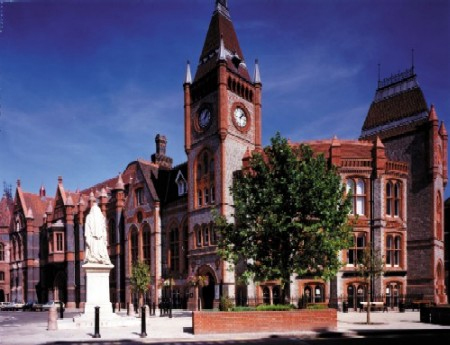Reading Branch History
Branch History

Brief outline history of the Reading Branch of the Historical Association
Reading is one of the places to have had a branch before the First World War, between 1908 and 1911 as was shown in The Historian, ‘The Branches of the Historical Association 1906-2006'. The story of the current Reading Branch, which can be traced in the annual reports to H.A. headquarters and, from the revival after the Second World War onwards, in the Minute Books and papers preserved by the Branch and now largely deposited with the Berkshire Record Office, begins however with the annual report for 1919-20. In that year it was reported that the ‘Reading and District' Branch of the Historical Association ‘was formed in January last, and the inaugural meeting was held in March'. At this meeting, the Master of Balliol, (A. L. Smith M.A.) ‘addressed a large gathering at the Hall of University College, Reading' - presumably the Great Hall on the London Road campus of what was to become the University of Reading. The term ‘a large gathering' is interesting; for while the membership numbers noted for this year are precisely 6, the next year numbers are noted as 250.
The name ‘Reading and District' meant what it said - the report notes that ‘the branch has been divided into sections according to locality, and meetings and excursions have been arranged for the different sections. Members may attend any of the sectional meetings'. The 1921-22 report gave the sections and their Secretaries, the sections being Reading, Slough, Eton and Windsor (‘Windsor and Eton' in 1922-23), and Maidenhead. In the reports however the branch is sometimes called ‘Reading' and sometimes ‘Reading and District'. The lecture topics reported are usually ‘Branch' lectures, with sometimes large numbers of ‘sectional' meetings also noted - fifteen in 1923-24! The Branch meetings were held in a variety of locations around the district.
The range of activities in the early years included talks on history from the medieval period to contemporary issues, visits, educational topics such as ‘The Value of History to Children' and work with schools, two members in 1921-22 being described as having ‘successfully entertained the children of Slough and Windsor Elementary Schools'. It was also planned to ‘initiate work in rural areas' and in 1922-23 reported that ‘the experiment of having lectures in a village was very successful'. Joint sessions were sometimes held with other societies and some members were reported as having done ‘a very useful piece of work' in transcribing Reading Borough Records.
By the 1930s themes were being tried, the ‘general subject for study' including topics such as ‘The Historical Background to some Present day Problems' and, in 1936-37, the ominous theme of ‘Dictators'. By 1939-40 it was reported that ‘Reading and District Branch found the difficulties of arranging meetings for a branch covering a wide and scattered area insuperable'; in 1940-41 no meetings were held, and by 1946-47 it was reported that the branch had remained ‘in abeyance'.
In 1948-49 however ‘a meeting to revive the Reading Branch was held at the University'. The Branch still possesses the Minute Book (a hardback school exercise book) from this revival. A lively and enthusiastic programme was pursued, with such enthusiasm that by 1953 the experiment of meetings every three weeks was tried, though soon there was ‘some evidence' that every three weeks was rather too frequent. Talks in this period were described as ‘stimulating and controversial' and the Branch declared its intention to ‘combine scholarship with popular appeal'. 1955 was described as a ‘memorable' year with a full programme of ‘sparkling' lectures.
By the later 1950s attendance had rather waned and in the early 1960s plaintive comments about attendance numbers can be found and the Minute Book becomes fragmentary, with brief entries and blank pages. In 1967 a ‘complete reorganisation' of the branch was reported and activities took off again, though the Branch was also saddened in this year by the death of Sir Frank Stenton, who had held office as President of the Branch for the first time in 1925-26 and had been central in the revival after the Second World War.
The 1970s were heralded with the purchase of a large new Minute Book and the decade saw the resurgence of the Branch with all sorts of information being circulated and a variety of activities being tried - cheese and wine evenings, members' evenings, a Forum section in a newsletter for members to share views, film screenings and discussions for schools, what the Minutes themselves describe as ‘more aggressive' publicity, a lecture from A.J.P. Taylor attended by more than 300 people and, by the later 1970s, an annual programme card and a constitution which tightened up Branch organisation and introduced specified periods of service for the President and Committee members.
The 1980s saw Reading as one of the regional locations for the discussions and consultations which the H.A. organised to contribute to the development of the National Curriculum. By the late 1980s however the Branch was worried about money and membership, reporting in 1988 that it would ‘make very effort to pull through'.
Pull through it did. In 1992 the H.A. Annual Conference was hosted at Reading in a partnership between the Reading Branch and the University of Reading History Department, and for the past two decades the Reading Branch has continued to offer a programme which had included a wide range of lecture topics, school-related activities, visits and the opportunity to dine with speakers.
Though the world of 2008 is in so much very different from that of 1908, what those in the early years often call the work of the Reading Branch - and in the early reports it is the word ‘work' which is used - can be seen in many ways still to relate well to their ideals and intentions.

